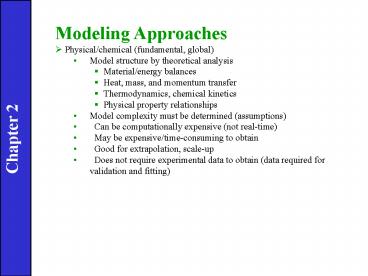Modeling Approaches PowerPoint PPT Presentation
1 / 20
Title: Modeling Approaches
1
- Modeling Approaches
- Physical/chemical (fundamental, global)
- Model structure by theoretical analysis
- Material/energy balances
- Heat, mass, and momentum transfer
- Thermodynamics, chemical kinetics
- Physical property relationships
- Model complexity must be determined (assumptions)
- Can be computationally expensive (not
real-time) - May be expensive/time-consuming to obtain
- Good for extrapolation, scale-up
- Does not require experimental data to obtain
(data required for validation and fitting)
Chapter 2
2
- Black box (empirical)
- Large number of unknown parameters
- Can be obtained quickly (e.g., linear regression)
- Model structure is subjective
- Dangerous to extrapolate
- Semi-empirical
- Compromise of first two approaches
- Model structure may be simpler
- Typically 2 to 10 physical parameters estimated
(nonlinear regression) - Good versatility, can be extrapolated
- Can be run in real-time
Chapter 2
3
- Conservation Laws
Theoretical models of chemical processes are
based on conservation laws.
Conservation of Mass
Chapter 2
Conservation of Component i
4
Conservation of Energy
The general law of energy conservation is also
called the First Law of Thermodynamics. It can be
expressed as
Chapter 2
The total energy of a thermodynamic system, Utot,
is the sum of its internal energy, kinetic
energy, and potential energy
5
- Development of Dynamic Models
- Illustrative Example A Blending Process
Chapter 2
An unsteady-state mass balance for the blending
system
6
or where w1, w2, and w are mass flow rates.
- The unsteady-state component balance is
Chapter 2
The corresponding steady-state model was derived
in Ch. 1 (cf. Eqs. 1-1 and 1-2).
7
The Blending Process Revisited
For constant , Eqs. 2-2 and 2-3 become
Chapter 2
8
Equation 2-13 can be simplified by expanding the
accumulation term using the chain rule for
differentiation of a product
Substitution of (2-14) into (2-13) gives
Chapter 2
Substitution of the mass balance in (2-12) for
in (2-15) gives
After canceling common terms and rearranging
(2-12) and (2-16), a more convenient model form
is obtained
9
Chapter 2
10
Stirred-Tank Heating Process
Chapter 2
Figure 2.3 Stirred-tank heating process with
constant holdup, V.
11
Stirred-Tank Heating Process (contd.)
- Assumptions
- Perfect mixing thus, the exit temperature T is
also the temperature of the tank contents. - The liquid holdup V is constant because the inlet
and outlet flow rates are equal. - The density and heat capacity C of the liquid
are assumed to be constant. Thus, their
temperature dependence is neglected. - Heat losses are negligible.
Chapter 2
12
- For the processes and examples considered in this
book, it - is appropriate to make two assumptions
- Changes in potential energy and kinetic energy
can be neglected because they are small in
comparison with changes in internal energy. - The net rate of work can be neglected because it
is small compared to the rates of heat transfer
and convection. - For these reasonable assumptions, the energy
balance in - Eq. 2-8 can be written as
Chapter 2
13
Model Development - I
For a pure liquid at low or moderate pressures,
the internal energy is approximately equal to the
enthalpy, Uint , and H depends only on
temperature. Consequently, in the subsequent
development, we assume that Uint H and
where the caret () means per unit mass. As
shown in Appendix B, a differential change in
temperature, dT, produces a corresponding change
in the internal energy per unit mass,
Chapter 2
where C is the constant pressure heat capacity
(assumed to be constant). The total internal
energy of the liquid in the tank is
14
Model Development - II
An expression for the rate of internal energy
accumulation can be derived from Eqs. (2-29) and
(2-30)
Note that this term appears in the general energy
balance of Eq. 2-10.
Chapter 2
Suppose that the liquid in the tank is at a
temperature T and has an enthalpy, .
Integrating Eq. 2-29 from a reference temperature
Tref to T gives,
where is the value of at Tref.
Without loss of generality, we assume that
(see Appendix B). Thus, (2-32) can be
written as
15
Model Development - III
For the inlet stream
Substituting (2-33) and (2-34) into the
convection term of (2-10) gives
Chapter 2
Finally, substitution of (2-31) and (2-35) into
(2-10)
16
Define deviation variables (from set point)
Chapter 2
17
Chapter 2
18
Table 2.2. Degrees of Freedom Analysis
- List all quantities in the model that are known
constants (or parameters that can be specified)
on the basis of equipment dimensions, known
physical properties, etc. - Determine the number of equations NE and the
number of process variables, NV. Note that time
t is not considered to be a process variable
because it is neither a process input nor a
process output. - Calculate the number of degrees of freedom, NF
NV - NE. - Identify the NE output variables that will be
obtained by solving the process model. - Identify the NF input variables that must be
specified as either disturbance variables or
manipulated variables, in order to utilize the NF
degrees of freedom.
Chapter 2
19
Degrees of Freedom Analysis for the Stirred-Tank
Model
3 parameters 4 variables 1 equation Eq. 2-36
Thus the degrees of freedom are NF 4 1 3.
The process variables are classified as
Chapter 2
1 output variable T 3 input variables Ti, w, Q
For temperature control purposes, it is
reasonable to classify the three inputs as
2 disturbance variables Ti, w 1 manipulated
variable Q
20
Degrees of Freedom Analysis for the Stirred-Tank
Model
3 parameters 4 variables 1 equation Eq. 2-36
Thus the degrees of freedom are NF 4 1 3.
The process variables are classified as
1 output variable T 3 input variables Ti, w, Q
For temperature control purposes, it is
reasonable to classify the three inputs as
2 disturbance variables Ti, w 1 manipulated
variable Q

